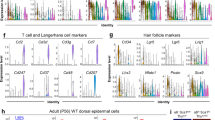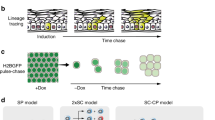Abstract
According to the current model of adult epidermal homeostasis, skin tissue is maintained by two discrete populations of progenitor cells: self-renewing stem cells; and their progeny, known as transit amplifying cells, which differentiate after several rounds of cell division1,2,3. By making use of inducible genetic labelling, we have tracked the fate of a representative sample of progenitor cells in mouse tail epidermis at single-cell resolution in vivo at time intervals up to one year. Here we show that clone-size distributions are consistent with a new model of homeostasis involving only one type of progenitor cell. These cells are found to undergo both symmetric and asymmetric division at rates that ensure epidermal homeostasis. The results raise important questions about the potential role of stem cells on tissue maintenance in vivo.
This is a preview of subscription content, access via your institution
Access options
Subscribe to this journal
Receive 51 print issues and online access
$199.00 per year
only $3.90 per issue
Buy this article
- Purchase on Springer Link
- Instant access to full article PDF
Prices may be subject to local taxes which are calculated during checkout




Similar content being viewed by others
References
Lajtha, L. G. Stem cell concepts. Differentiation 14, 23–34 (1979)
Alonso, L. & Fuchs, E. Stem cells of the skin epithelium. Proc. Natl Acad. Sci. USA 100, (suppl. 1)11830–11835 (2003)
Braun, K. M. & Watt, F. M. Epidermal label-retaining cells: background and recent applications. J. Invest. Dermatol. Symp. Proc. 9, 196–201 (2004)
Gambardella, L. & Barrandon, Y. The multifaceted adult epidermal stem cell. Curr. Opin. Cell Biol. 15, 771–777 (2003)
Tumbar, T. et al. Defining the epithelial stem cell niche in skin. Science 303, 359–363 (2004)
Morris, R. J. et al. Capturing and profiling adult hair follicle stem cells. Nature Biotechnol. 22, 411–417 (2004)
Levy, V., Lindon, C., Harfe, B. D. & Morgan, B. A. Distinct stem cell populations regenerate the follicle and interfollicular epidermis. Dev. Cell 9, 855–861 (2005)
Ito, M. et al. Stem cells in the hair follicle bulge contribute to wound repair but not to homeostasis of the epidermis. Nature Med. 11, 1351–1354 (2005)
Claudinot, S., Nicolas, M., Oshima, H., Rochat, A. & Barrandon, Y. Long-term renewal of hair follicles from clonogenic multipotent stem cells. Proc. Natl Acad. Sci. USA 102, 14677–14682 (2005)
Mackenzie, I. C. Relationship between mitosis and the ordered structure of the stratum corneum in mouse epidermis. Nature 226, 653–655 (1970)
Potten, C. S. The epidermal proliferative unit: the possible role of the central basal cell. Cell Tissue Kinet. 7, 77–88 (1974)
Ghazizadeh, S. & Taichman, L. B. Multiple classes of stem cells in cutaneous epithelium: a lineage analysis of adult mouse skin. EMBO J. 20, 1215–1222 (2001)
Kameda, T. et al. Analysis of the cellular heterogeneity in the basal layer of mouse ear epidermis: an approach from partial decomposition in vitro and retroviral cell marking in vivo. Exp. Cell Res. 283, 167–183 (2003)
Ro, S. & Rannala, B. A stop-EGFP transgenic mouse to detect clonal cell lineages generated by mutation. EMBO Rep. 5, 914–920 (2004)
Ro, S. & Rannala, B. Evidence from the stop-EGFP mouse supports a niche-sharing model of epidermal proliferative units. Exp. Dermatol. 14, 838–843 (2005)
Srinivas, S. et al. Cre reporter strains produced by targeted insertion of EYFP and ECFP into the ROSA26 locus. BMC Dev. Biol. 1, 4 (2001)
Kemp, R. et al. Elimination of background recombination: somatic induction of Cre by combined transcriptional regulation and hormone binding affinity. Nucleic Acids Res. 32, e92 (2004)
Braun, K. M. et al. Manipulation of stem cell proliferation and lineage commitment: visualisation of label-retaining cells in wholemounts of mouse epidermis. Development 130, 5241–5255 (2003)
Williams, G. H. et al. Improved cervical smear assessment using antibodies against proteins that regulate DNA replication. Proc. Natl Acad. Sci. USA 95, 14932–14937 (1998)
Birner, P. et al. Immunohistochemical detection of cell growth fraction in formalin-fixed and paraffin-embedded murine tissue. Am. J. Pathol. 158, 1991–1996 (2001)
Potten, C. S. Cell replacement in epidermis (keratopoiesis) via discrete units of proliferation. Int. Rev. Cytol. 69, 271–318 (1981)
Das, T., Payer, B., Cayouette, M. & Harris, W. A. In vivo time-lapse imaging of cell divisions during neurogenesis in the developing zebrafish retina. Neuron 37, 597–609 (2003)
Gho, M. & Schweisguth, F. Frizzled signalling controls orientation of asymmetric sense organ precursor cell divisions in Drosophila. Nature 393, 178–181 (1998)
Lechler, T. & Fuchs, E. Asymmetric cell divisions promote stratification and differentiation of mammalian skin. Nature 437, 275–280 (2005)
Smart, I. H. Variation in the plane of cell cleavage during the process of stratification in the mouse epidermis. Br. J. Dermatol. 82, 276–282 (1970)
Zhong, W., Feder, J. N., Jiang, M. M., Jan, L. Y. & Jan, Y. N. Asymmetric localization of a mammalian numb homolog during mouse cortical neurogenesis. Neuron 17, 43–53 (1996)
Conboy, I. M. & Rando, T. A. The regulation of Notch signaling controls satellite cell activation and cell fate determination in postnatal myogenesis. Dev. Cell 3, 397–409 (2002)
Smart, F. M. & Venkitaraman, A. R. Inhibition of interleukin 7 receptor signaling by antigen receptor assembly. J. Exp. Med. 191, 737–742 (2000)
Temple, S. & Raff, M. C. Clonal analysis of oligodendrocyte development in culture: evidence for a developmental clock that counts cell divisions. Cell 44, 773–779 (1986)
Acknowledgements
We thank Y. Amagase for performing RT–PCR, E. Choolun and R. Walker for technical assistance, S. Penrhyn-Lowe and T. Mills for help with microscopy and R. Laskey, W. Harris, A. Philpott and C. Jones for comments. This work was funded by the Medical Research Council, Association for International Cancer Research and Cancer Research UK.
Author Contributions Experimental work was performed by E.C., D.P.D. and P.H.J., project planning by P.H.J. and D.J.W., biophysical analysis by B.D.S. and A.M.K.
Author information
Authors and Affiliations
Corresponding author
Ethics declarations
Competing interests
Reprints and permissions information is available at www.nature.com/reprints. The authors declare no competing financial interests.
Supplementary information
Supplementary Information 1
This file contains Supplementary Methods, Supplementary Figures S1-S8 with Legends, Supplementary Table 1 and additional results. This section contains additional experimental methods, clone size data for back skin epidermis, the fate of differentiated clones, analysis of tissue growth, cell proliferation, cell migration, apoptosis and mitotic spindle orientation in tail epidermis. (PDF 1780 kb)
Supplementary Information 2
This file contains Supplementary Discussion and Supplementary Figures S9-S11 with Legends. This section contains a detailed analysis of why previous models do not explain the present data, and the derivation of the single compartment model of the epidermis. (PDF 253 kb)
Rights and permissions
About this article
Cite this article
Clayton, E., Doupé, D., Klein, A. et al. A single type of progenitor cell maintains normal epidermis. Nature 446, 185–189 (2007). https://doi.org/10.1038/nature05574
Received:
Accepted:
Published:
Issue Date:
DOI: https://doi.org/10.1038/nature05574
Comments
By submitting a comment you agree to abide by our Terms and Community Guidelines. If you find something abusive or that does not comply with our terms or guidelines please flag it as inappropriate.



